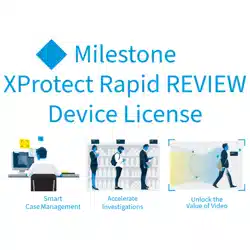Loading ...
Loading ...
Loading ...

APPENDIX: XProtect Rapid REVIEW hardware
recommendations
This section aims to assist in selecting hardware for a system that will run XProtect Rapid REVIEW.
At the core of these systems are the graphical processing units (GPUs) that are responsible for processing the
original video and extracting metadata. The number/type of GPUs, the resolution of the original video, frame
rate, and activity determine the number of hours of original video that can be processed per day (or per hour).
The more GPUs (and processing servers) a system has, the more original video it can process in an hour.
In addition to the GPUs, the system also relies on the CPU to support this video processing and the
investigations that follow the processing – when the user filters through the various objects, measures
proximity, and plays a VIDEO SYNOPSIS®.
The all-in-one, single server systems, cover a range of CPUs and a number of GPUs (from 1 to 4).
For systems that require more GPUs, BriefCam offers distributed architecture where the GPUs are located on
dedicated Processing Servers alongside additional servers that run the BriefCam services (such as perform
filtering and play a VIDEO SYNOPSIS®).
These hardware specs can be defined by their processing throughput (the number of hours of original video
that can be processed within an hour of processing or per day). These are measured under certain input video
characteristics, such as resolution and activity level.
When we refer to an activity level, we refer to the number of objects that pass through the scene in an hour,
under certain movement patterns.
We benchmarked the throughputs in this document under medium activity – which refers to roughly 1,000
objects (people and vehicles detected by the analytics engine) per hour.
The throughputs listed below each hardware spec relate to the throughput of the machine (based on the
throughput of the GPUs) – the VMS and network architecture and infrastructure need to support this
throughput as well.
Several users can use the system concurrently, but this will increase the load on the system. Our
recommendations and design assumptions are for a maximum of 2 concurrent users.
Face Recognition and License Plate Recognition Watchlist searches require resources. Our recommendations
assume watchlists of less than 10,000 identities in total (across all of the used watchlists combined).
All-in-One configurations
This section aims to assist in selecting hardware for a system that runs XProtect Rapid REVIEW in All-in-One
Configurations.
Installation and deployment guide | XProtect® Rapid REVIEW
60 | APPENDIX: XProtect Rapid REVIEW hardware recommendations
Loading ...
Loading ...
Loading ...
